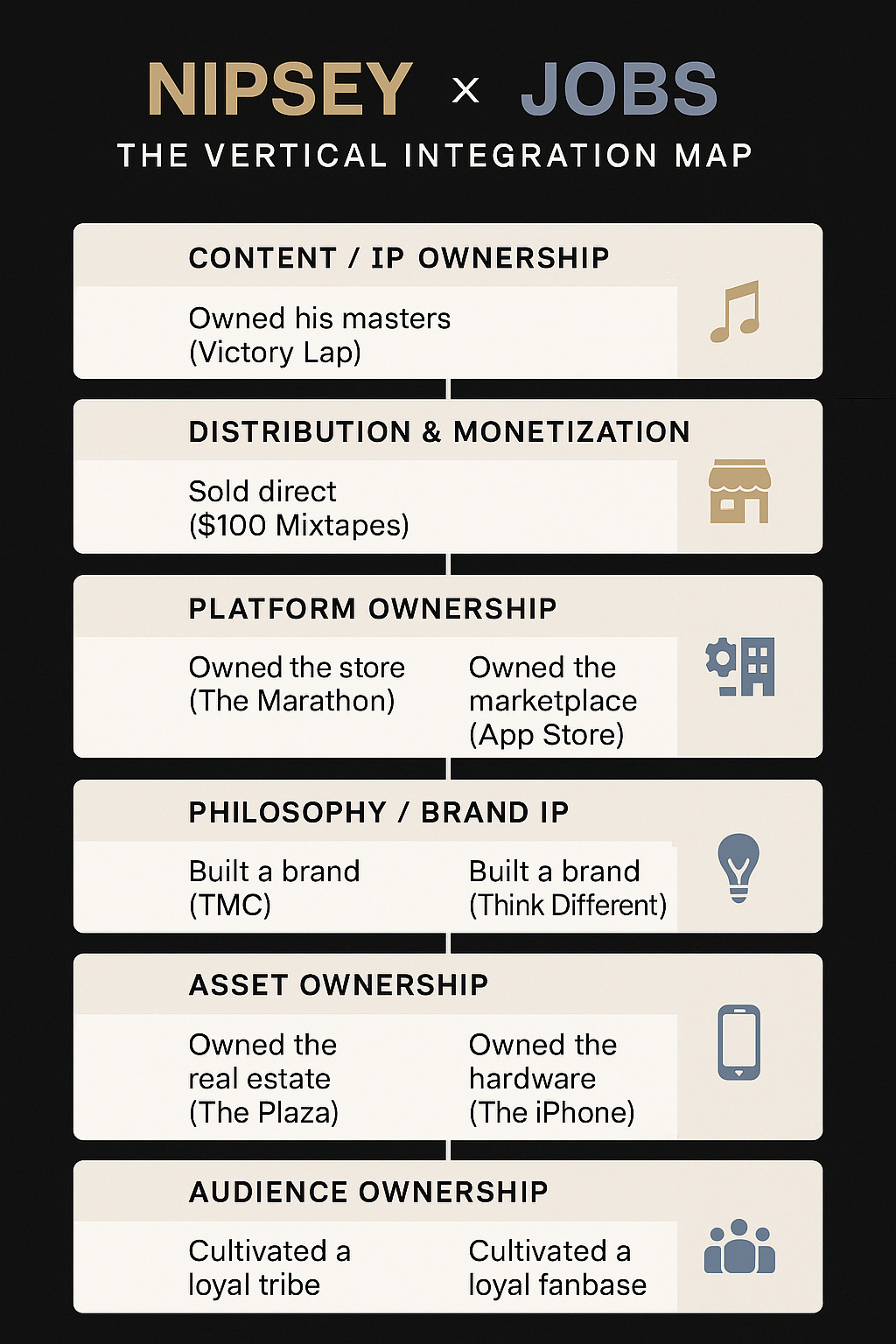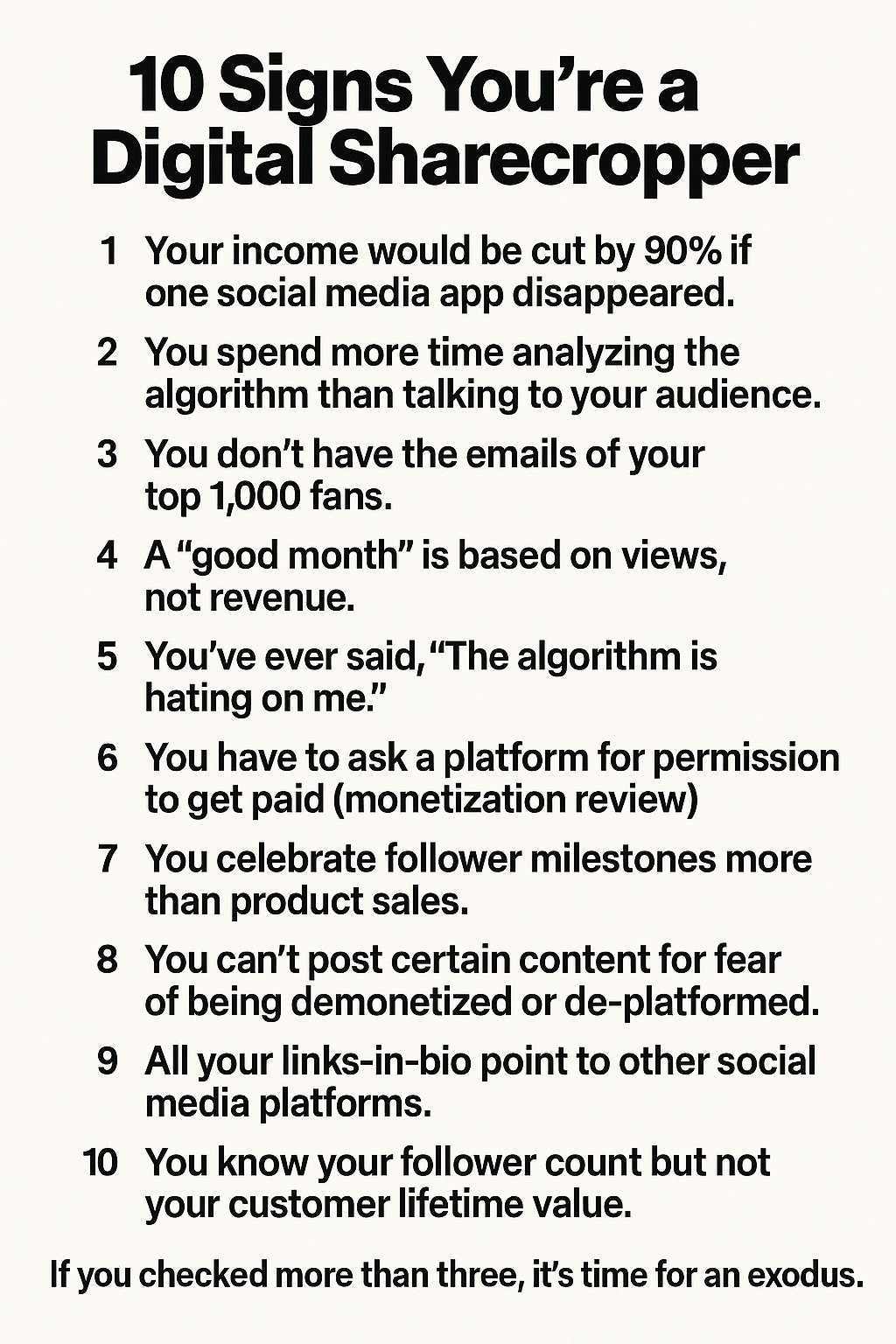The Digital Sharecropper’s Exodus: A New Blueprint for Ownership
The Plantation Has Wi-Fi: Understanding the New Digital Sharecropping
Let’s start with a question that’s gonna make some of y’all uncomfortable.
How do you have a million followers but can’t pay your rent on time?
It’s the great contradiction of our time. We see creators with massive online clout who are one bad month away from going broke. They’re drowning in influence but starved for capital. This isn’t a personal failure, Kinfolk. It’s a systemic one. It's the design of a system we call Digital Sharecropping.
Let's be clear on what this is: It’s a modern-day plantation where the fields are digital platforms, and the crop is your creativity. You labor on land you don’t own (Instagram, TikTok, YouTube) to produce value you don’t fully control or capture.
Don't believe me? Let's run the numbers. The average YouTuber with a million views might see $3,000 to $5,000. For a TikToker, it's pennies on the dollar. On Instagram, you're not getting paid unless you're hawking detox tea or pushing affiliate links in your bio. You’re not a partner; you’re the product.
You are a tenant. Period. You’re subject to the whims of an algorithmic landlord who can change the terms of your lease overnight. One algorithm shift, one shadowban, one "community guideline violation" on a post that was fine last week, and your entire business is on life support. You didn’t sign off on it, but you’re living with the consequences.
It ain’t just the up-and-comers, either. Veteran creators like Hank Green have openly admitted they can have a video go massively viral and still struggle to cover basic operational costs like healthcare for their team.
Let this sink in.
“If it ain’t your land, your list, or your link, you’re leasing your life out—one upload at a time.”
Nipsey & Jobs: The Blueprint in Stereo
The escape route from this trap wasn't drawn up in a Silicon Valley boardroom. The blueprint for real ownership was laid down in two very different hoods: Crenshaw and Cupertino.
This is the soul of the mission. Not just vibes—architecture.
First, you had Nipsey Hussle. The Marathon Continues wasn't just a movement; it was a masterclass in street-level vertical integration. He preached “All Money In” because it was a real strategy, not a slogan. Why sell your album through a label when you can sell your own $100 Mixtape direct to your core fans and keep every dollar? Why rent a retail spot when you can own the masters, own the Marathon store that sells the merch, and own the damn plaza the store sits in? He understood that the only way to win was to remove the middleman and own the entire value chain.
Then you had Steve Jobs. A world away, he was engineering the same principle with holistic, fanatical control. He didn’t just design the iPhone; he obsessed over the chip inside it, the iOS that ran it, the App Store that monetized it, and the Apple Store that sold it. Apple doesn’t just play in an ecosystem; they are the ecosystem. They are the landlord, the government, and the bank, all in one.
Listen, and listen good.
“Nipsey and Jobs spoke different languages, but they built the same damn building: a vertically integrated empire with no landlord but themselves.”
This isn't just a dope comparison. This is the code. And The Ownership Stack™ is the key that translates that code into a roadmap for every creator, artist, and builder ready to claim their sovereignty.
Introducing: The Ownership Stack™
You can't scale freedom if you don't own the blueprint. Talk is cheap. You need a framework. A ladder.
The Ownership Stack™ is that ladder. Each rung represents a layer of control you must reclaim from the platforms and secure for yourself.
Layer 1: Audience Ownership
The Move: Stop borrowing audiences from algorithms. Build direct, unbreakable relationships.
The Action: Your email list. Your SMS list. Your private community on a platform you control. This is your real follower count.
Layer 2: Content/IP Ownership
The Move: Own your masters. Stop giving away your genius for free.
The Action: Register your trademarks and copyrights. Structure your deals to retain ownership. License your work with leverage, don't just hand it over.
Layer 3: Platform Ownership
The Move: Stop being a tenant. Become the owner of the house.
The Action: Host your community on your own terms. Build your own app. License white-label tech. Create your own digital home base where you set the rules.
Layer 4: Distribution Ownership
The Move: Control the pipes. Don't just make the content; decide how it travels.
The Action: Own your podcast's RSS feed. Drive traffic to your own website or app, not just a platform profile. Build syndication deals where you control the terms.
Layer 5: Monetization Ownership
The Move: Fire the platform ad-revenue department. Build your own economy.
The Action: Sell your own products, services, and memberships. Create direct payment funnels. Stop relying on a fluctuating cut from a corporation that doesn't know your name.
Layer 6: Data Ownership
The Move: Know your people better than the platforms do.
The Action: Use your own analytics. Understand your community’s behavior on your own terms. Build your own algorithm—one that serves your people, not just advertisers.
“They don’t want us to own the field. So we’re building the damn stadium.”
Algorithmic Addiction is a Death Trap
Let’s treat this next part like a public health warning, because it is.
The platforms have engineered an addiction. They’ve trained an entire generation of creators to chase the short-term dopamine hit of virality over the long-term equity of value. You're rewarded for being loud, not for being essential. You're celebrated for being seen, not for being sustained.
Every time you change your content to please the algorithm, you’re giving up a piece of your sovereignty. You become a puppet dancing on strings held by a machine designed to keep you running in a hamster wheel.
The case studies write themselves. You see TikTokers with 10 million followers go broke the second the trends shift, while Substack writers with 10,000 true fans on an email list are building multi-six-figure businesses. One is an influencer. The other is an institution.
Remember this. Burn it into your brain.
“If the algorithm decides your destiny, it already owns your future.”
From Digital Sharecropper to Digital Sovereign
This is where we pivot. This is where hope meets the hustle. The exodus isn’t about running from something; it’s about building towards something.
The Digital Sovereign is the creator who understands the blueprint. They are taking back their masters, their messaging, and their money. They are applying the principles of vertical integration—not as a tech giant or a rap mogul—but as a sovereign individual.
They are building their Ownership Stack, layer by layer. They are transforming their audience into a community, their content into assets, and their influence into an independent economy.
This isn't a fantasy. This is the work. And platforms like Kin, and the entire Kin Worldwide ecosystem, are being purpose-built to serve as the arsenal for this movement. We’re not just creating an escape from exploitation; we are building the launchpad for empire-building.
A Manifesto Moment: The Declaration of Digital Independence
So we end where we must begin: with a declaration. This is the line in the sand. This is the moment we stop asking for a seat at their table and start building our own house.
We are no longer just talent. We are builders, owners, architects.
We will no longer rent space on platforms that profit from our presence while limiting our power.
We will no longer trade ownership for likes, or equity for exposure.
We are not influencers—we are institutions in the making.
This is not rebellion. This is reprogramming.



